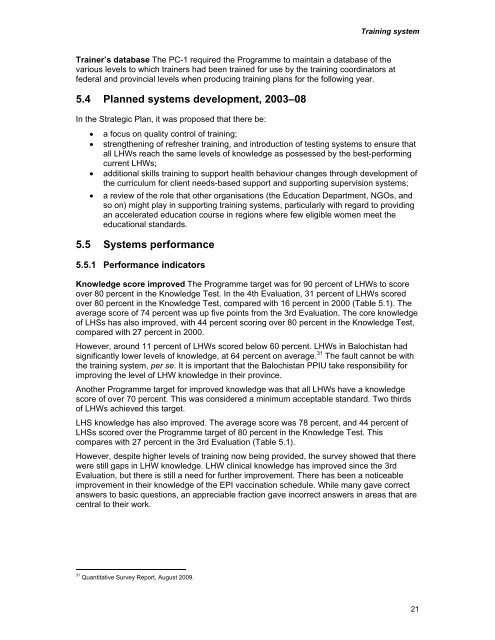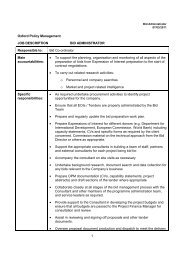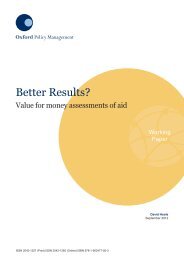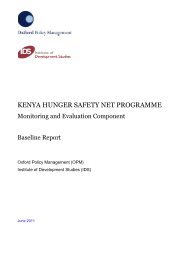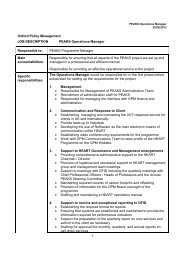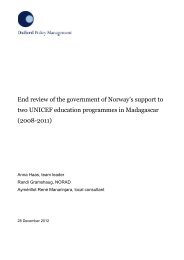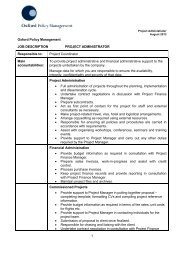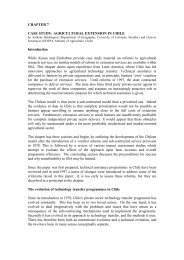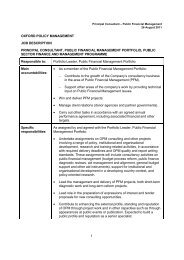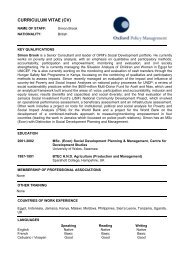LHW Systems Review - Oxford Policy Management
LHW Systems Review - Oxford Policy Management
LHW Systems Review - Oxford Policy Management
Create successful ePaper yourself
Turn your PDF publications into a flip-book with our unique Google optimized e-Paper software.
Training systemTrainer’s database The PC-1 required the Programme to maintain a database of thevarious levels to which trainers had been trained for use by the training coordinators atfederal and provincial levels when producing training plans for the following year.5.4 Planned systems development, 2003–08In the Strategic Plan, it was proposed that there be:• a focus on quality control of training;• strengthening of refresher training, and introduction of testing systems to ensure thatall <strong>LHW</strong>s reach the same levels of knowledge as possessed by the best-performingcurrent <strong>LHW</strong>s;• additional skills training to support health behaviour changes through development ofthe curriculum for client needs-based support and supporting supervision systems;• a review of the role that other organisations (the Education Department, NGOs, andso on) might play in supporting training systems, particularly with regard to providingan accelerated education course in regions where few eligible women meet theeducational standards.5.5 <strong>Systems</strong> performance5.5.1 Performance indicatorsKnowledge score improved The Programme target was for 90 percent of <strong>LHW</strong>s to scoreover 80 percent in the Knowledge Test. In the 4th Evaluation, 31 percent of <strong>LHW</strong>s scoredover 80 percent in the Knowledge Test, compared with 16 percent in 2000 (Table 5.1). Theaverage score of 74 percent was up five points from the 3rd Evaluation. The core knowledgeof LHSs has also improved, with 44 percent scoring over 80 percent in the Knowledge Test,compared with 27 percent in 2000.However, around 11 percent of <strong>LHW</strong>s scored below 60 percent. <strong>LHW</strong>s in Balochistan hadsignificantly lower levels of knowledge, at 64 percent on average. 31 The fault cannot be withthe training system, per se. It is important that the Balochistan PPIU take responsibility forimproving the level of <strong>LHW</strong> knowledge in their province.Another Programme target for improved knowledge was that all <strong>LHW</strong>s have a knowledgescore of over 70 percent. This was considered a minimum acceptable standard. Two thirdsof <strong>LHW</strong>s achieved this target.LHS knowledge has also improved. The average score was 78 percent, and 44 percent ofLHSs scored over the Programme target of 80 percent in the Knowledge Test. Thiscompares with 27 percent in the 3rd Evaluation (Table 5.1).However, despite higher levels of training now being provided, the survey showed that therewere still gaps in <strong>LHW</strong> knowledge. <strong>LHW</strong> clinical knowledge has improved since the 3rdEvaluation, but there is still a need for further improvement. There has been a noticeableimprovement in their knowledge of the EPI vaccination schedule. While many gave correctanswers to basic questions, an appreciable fraction gave incorrect answers in areas that arecentral to their work.31Quantitative Survey Report, August 2009.21


